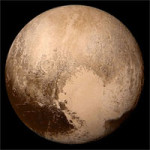by Erich Karkoschka
 Brillant Venus outshines all the stars in the morning sky, passing Spica on the 16th. Far below Venus is Mercury, next to Spica on the 2nd. By the 10th at greatest elongation, it is as
Brillant Venus outshines all the stars in the morning sky, passing Spica on the 16th. Far below Venus is Mercury, next to Spica on the 2nd. By the 10th at greatest elongation, it is as
easy to see as it can be seen  from our latitude. It disappears at the end of the month.
from our latitude. It disappears at the end of the month.
 The crescent moon stands between Mercury and Venus on the morning of the 13th, near Jupiter and Saturn on the 18th and 19th, and finally just below Mars on the 25th.
The crescent moon stands between Mercury and Venus on the morning of the 13th, near Jupiter and Saturn on the 18th and 19th, and finally just below Mars on the 25th.
 Mars is conspicuous since it is bright orange and high in the sky all evening. It is still 20 arc-sec in diameter so that telescopes show fine detail. However, it is receeding fast. By the end of the
Mars is conspicuous since it is bright orange and high in the sky all evening. It is still 20 arc-sec in diameter so that telescopes show fine detail. However, it is receeding fast. By the end of the
month, it is less than half as bright and only 15 arc-sec in diameter. Nevertheless, this is still better than the maximum in some oppositions.
Minor planet Flora No. 8 can be found with binoculars as magnitude 8 in Cetus, well placed in the evening sky. It is its best showing between 1980 and 2060.
 Jupiter and Saturn are well up during the early evening, transiting
Jupiter and Saturn are well up during the early evening, transiting
just before sunset. Saturn is 5 degrees east of Jupiter during early
November, closing to 2 degrees by the end. We are not far from their closest
conjunction in centuries, on  December 21. On the 2nd, a telescope shows Callisto in transit as a dark spot. On the 8th, the dark spot is the shadow of Ganymede, and on the 15th after 7pm, it is Ganymede itself. Finally, on the 19th until 6:40 pm, it is Callisto again.
December 21. On the 2nd, a telescope shows Callisto in transit as a dark spot. On the 8th, the dark spot is the shadow of Ganymede, and on the 15th after 7pm, it is Ganymede itself. Finally, on the 19th until 6:40 pm, it is Callisto again.
 Uranus and Neptune are also well up in the evening. Neptune transits earlier than Mars. Uranus transits at midnight in early November since it came into opposition October 31st.
Uranus and Neptune are also well up in the evening. Neptune transits earlier than Mars. Uranus transits at midnight in early November since it came into opposition October 31st.
 Pluto is easy to find on the 14th since it is only 41 arc-min south of Jupiter. But it still is a challenge to identify it among hundreds
Pluto is easy to find on the 14th since it is only 41 arc-min south of Jupiter. But it still is a challenge to identify it among hundreds
of other stars of similar magnitude, 14 mag.
 On the morning of the 30th, there will be a penumbral lunar eclipse with a maximum at 2:43 am. Since 85 % of the moon will be inside the penumbra, it will be noticeable with the northern edge significantly darkened.
On the morning of the 30th, there will be a penumbral lunar eclipse with a maximum at 2:43 am. Since 85 % of the moon will be inside the penumbra, it will be noticeable with the northern edge significantly darkened.


